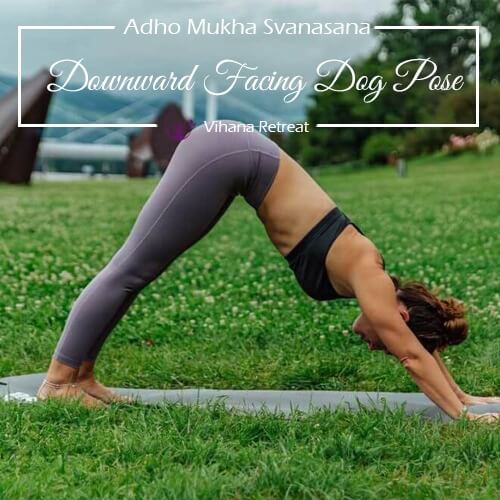Yoga For Depression & Anxiety: Introduction
1. Plough Pose (Halasana) For Anxiety & Depression
This pose is a great way to stretch out the shoulders and open your chest. If you are new to yoga, we recommend that you learn this pose with an instructor or mentor who can help guide you through proper alignment.
To do Plough Pose (Halasana) -
- Begin by lying on your back with your legs extended and feet together.
- Bend both knees, bringing them toward your chest as if preparing for a butterfly stretch.
- Walk your hands underneath both sides of each thigh so that they rest on top of the outer knee joint.
- Reach for opposite elbows and clasp hands together, making sure not to pull too hard or arch your back excessively during this step—it's all about gentle stretching!
- Lie back down into the starting position with arms above head in a "T" formation, palms facing forward (this will be easier if someone is assisting).
- Slowly lower yourself toward the floor until neck muscles become engaged (you may feel like there is tension around the throat) but do not lift the head up off the floor.
- Keep the chin tucked away from your chest slightly as neck muscles relax into the cervical spine curve; keep breathing throughout the entire journey down into pose.
- Try not to push too much weight onto the neck by distributing evenly across the upper body while keeping shoulders relaxed or gently lifting up off ground slightly if needed—this should help release some tension in shoulder blades so they don't press against vertebrae in the neck area while lying face-up.
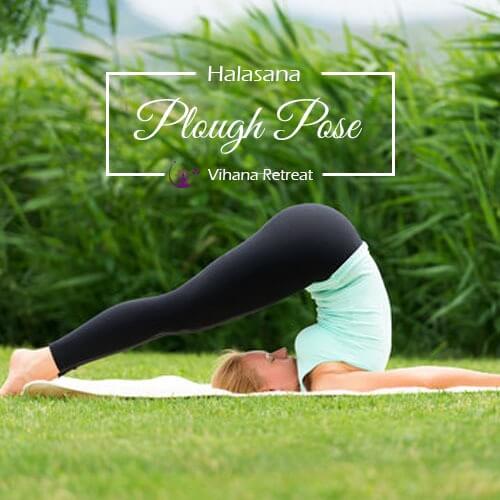
2. Child's Pose (Balasana)
Child's Pose is a resting pose that can help relieve stress and anxiety. This is one of the best poses to do after a long day, or before bedtime. It can also be helpful for people with insomnia to relax before bed, as it puts you in a relaxed state and lowers heart rate, which are both factors that may help you fall asleep.
Child’s Pose is an excellent way to warm up your body before more active yoga practices such as Sun Salutations or Vinyasa Flow Yoga Series.
How to perform Child's Pose?
- Start on all fours with hands directly under shoulders and knees directly under hips—this is the tabletop position.
- Lift hips up off the ground until only knees remain bent and feet flat on the floor.
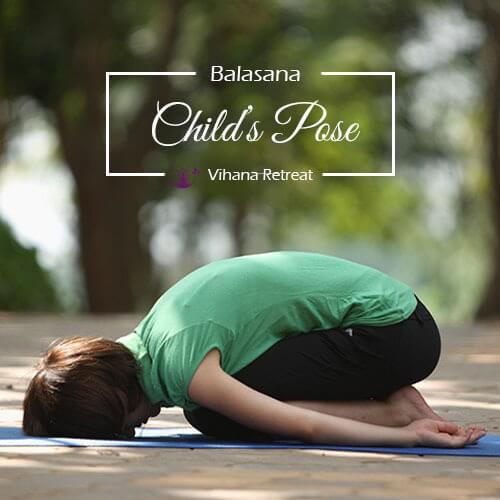
Looking for A Depression Retreat Retreat?
Our Retreats for Depression, Stress and Anxiety at Vihana is designed to help you find balance and stresses in your life, so that you can achieve a more positive mindset.
3. Standing Forward Bend (Uttanasana)
Standing Forward Bend (Uttanasana) is a great pose to help bring your mind and body into the present moment. It can help you de-stress, feel grounded, and gain perspective on your emotions.
To do this pose:
- Stand with your feet slightly wider than hip-width apart.
- Roll up onto your toes, and draw the heads of each thighbone back toward their hips as you fold forward at the waist.
- Reach down toward your toes with both hands; if that's not possible or comfortable, reach toward a wall in front of you instead or simply rest them on top of one another in front of your chest.
- Bring awareness to the sensations within yourself—perhaps what it feels like inside when you're anxious or depressed? What do those states feel like physically? Mentally? Emotionally?
- Take a deep breath. As you exhale, lift both legs from the floor by pressing your back against the ground.
- Stay in this position for up to five minutes (or longer if desired), then release slowly back up into normal standing alignment by drawing together all four corners of each foot with every inhalation and releasing them all away from each other with every exhalation until all four points are finally reconnected once again firmly underneath us.
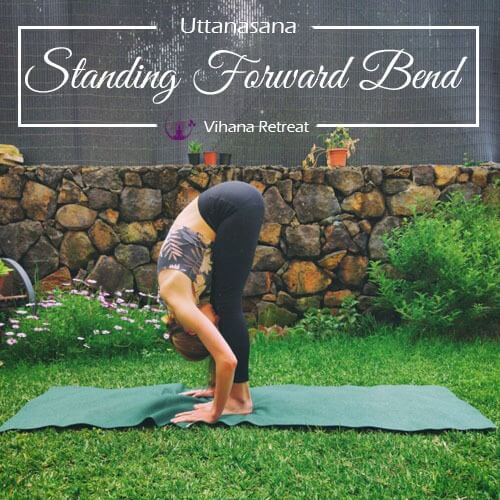
4. Head-to-Knee Forward Bend (Janu Sirsasana)
"Sirsa" means head and "janu" means knee in Sanskrit. The practitioner is asked to bend the right knee and hold the foot with the right hand while keeping the left leg straight with feet placed together and hands placed on the floor by your sides. This pose allows for stretching of both legs simultaneously which helps achieve flexibility faster than other prenatal exercises like walking or jogging."
How to Practice Head-to-Knee Forward Bend?
- You can do this pose on the floor or on a chair.
- To start, sit cross-legged, then bring your left foot to rest beside your right knee.
- Place the palms of your hands on either side of your feet, palms facing upward.
- While taking long deep breaths in and out through the nose, begin to lean forward over your legs until you feel pressure on the palms of your hands—the more weight you put into them, the deeper this stretch will be.
- You should feel an intense stretch from this position that runs throughout the front body (from shoulders to hips).
- Hold for up to three minutes if possible; if it feels too intense to hold for this long try just holding it for 20 seconds at first before increasing it by 5-second intervals until you can comfortably hold it for 3 minutes straight.
- Afterwards, come back up into sitting with knees crossed and repeat either side—you may also want to try taking a leg behind yourself for an extra stretch!
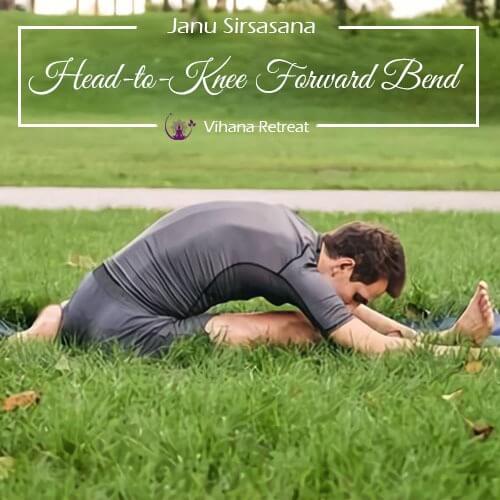
5. Seated Wide Angle Forward Bend (Upavistha Konasna)
The seated wide angle forward bend is a great way to stretch the hips, hamstrings and lower back. The pose can be done on a chair or on a yoga mat. A strap or block can be used to help take pressure off the knees if needed.
This pose is one of the most widely practiced poses in yoga, and is great for relaxation and stress reduction. In addition to the physical benefits, forward bends also allow us to introspect and calm our minds. Let's get into how to practice seated wide angle forward bend:
How to Practice Seated Wide Angle Forward Bend?
- Sit on the edge of a folded blanket with your legs extended in front of you. Bend the right knee and then place the sole of the foot on the inner left thigh.
- Flex both feet, press actively through your heels and feel how this action lifts your arches.
- Inhale and lift up through the spine to lengthen it; then exhale, bending forward from your hip joints.
- Lengthen your front torso as much as possible while you continue to spin your inner thighs down to the floor.
- On each inhalation, lift a little more through your torso; on each exhalation, fold a little more. This way each movement becomes an active process that says "yes" to both the back and front bodies.
- Allow your head to hang from the root of the neck.
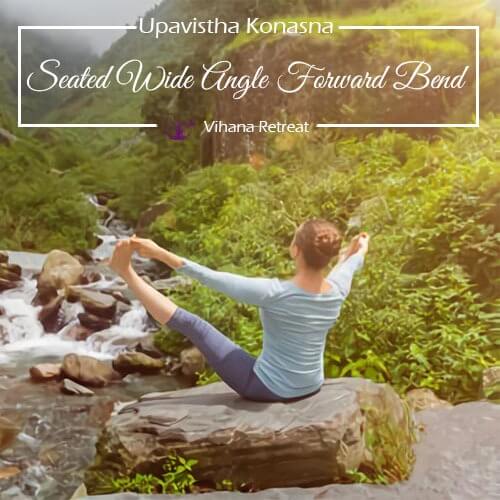
6. Seated Bound Angle Pose (Baddha Konasana)
Seated Bound Angle Pose (Baddha Konasana) is a great pose to relax, open the hips and relieve tension in the lower back. It’s also good for digestion because it massages internal organs in their natural positions.
Since the pose encourages meditation and stillness, it can be helpful for stress relief. When we are stressed out our minds tend to race; this pose helps calm the mind by encouraging you to focus on one thing: your breath.
The way it enables us to connect with our breath — while being mindful — causes a decrease in anxiety levels. It also provides an opportunity for self-reflection through meditation techniques like a mantra or focusing on an object such as candlelight or incense smoke. The end result is a sense of calmness that lasts even after leaving class!
Seated Bound Angle Pose
- It on the floor with your legs stretched out in front of you.
- Bend your knees and draw the soles of your feet together.
- Press your feet together and open your knees, allowing the side of your feet to rest on the floor.
- Firm the outer thighs and sit up tall.
- Hold for 30 seconds to a minute, then slowly release.
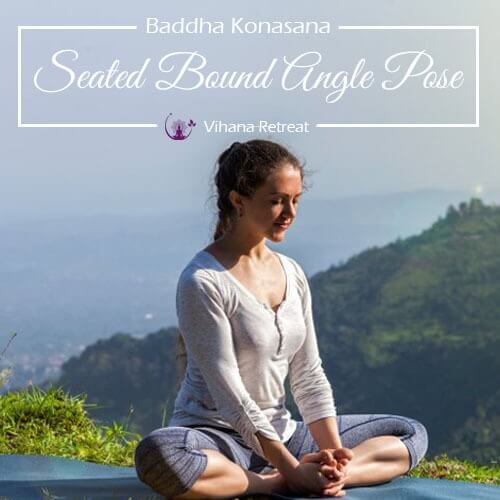
7. Cat-Cow Pose (Chakravakrasana)
This pose is a gentle backbend that can help relieve a variety of ailments. It is believed to relieve stress, headaches, depression and anxiety.
It may also help with digestion issues because of the twisting motion involved. In addition to these benefits for your mind and body, this yoga pose also helps strengthen your core muscles and improve flexibility in your spine.
The cat-cow movement promotes blood flow through the spine which will further aid in relieving back pain as well as helping with menstrual cramps by stimulating circulation to the lower abdominal area where menstrual cramps occur from poor circulation due to being overweight or having an unbalanced diet full of processed foods like white flour & sugar which causes inflammation throughout all parts of our bodies!
How to Perform Cat-Cow Pose?
- Get on your hands and knees.
- Inhale as you drop your belly toward the floor.
- Lift your chin and chest, and gaze up toward the ceiling.
- Take it further: Raise your right arm toward the ceiling and your left leg toward the wall behind you. Repeat on other side. Hold for 5 deep breaths.
- Cow Pose 1 is a gentle stretch that opens up the whole front of the body, while also gently toning the abdominal organs.
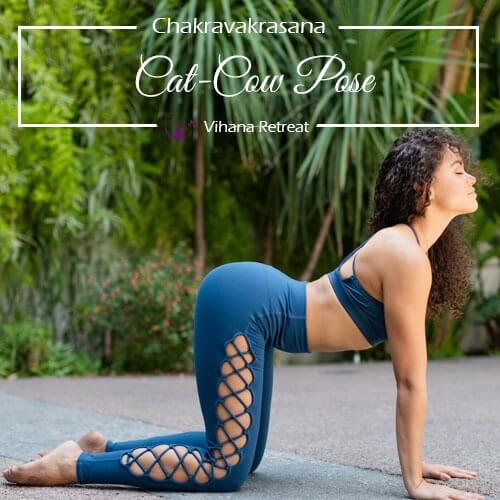
8. Legs Up the Wall Pose (Viparita Karani)
Viparita Karani is a yoga asana, which is a deep twisting inversion. When you perform this asana you face the floor and arch your body backwards to be upright again. This action reverses your hip joints so that they gradually roll into the opposite position of forward flexion.
At the same time it lifts your legs high off the floor towards the back of your body and bends both feet towards the hips. The two points of contact are just above your tailbone and on either side of your pelvis. One complete iteration will leave you completely relaxed.
Every single muscle in your body thins out as it relaxes during this pose as it moves from a hyper-extension to supination – it only takes up one minute worth of energy from your spine when using gravity!
How to Perform Legs Up the Wall Pose?
- Lie down with your back to the wall and place your feet up against it. Your legs should be straight and parallel, with your feet flat on the floor.
- Spread your knees and slide them toward each other so that you can fit between them; this will create more space for the lower back.
- Keeping your arms by your side, bend your right knee and kick up with your right foot, aiming to put the sole of that foot against your left inner thigh.
- Drop both shoulders down toward the floor as much as possible, then let both arms hang by your sides with palms facing upward (or gently bend them in toward each other).
- Extend through the crown of your head so that it touches lightly against the wall behind you—feel free to use an eye pillow if it helps relax you more fully into this position!
- Stay here for five minutes or longer if desired; if at any point during this pose you feel pain in any part of your body, come out of it immediately and gently shift yourself until another position feels comfortable again without putting pressure on anything that hurts or feels tense/tight/stiffened up/etc., etc., etc…you get it!
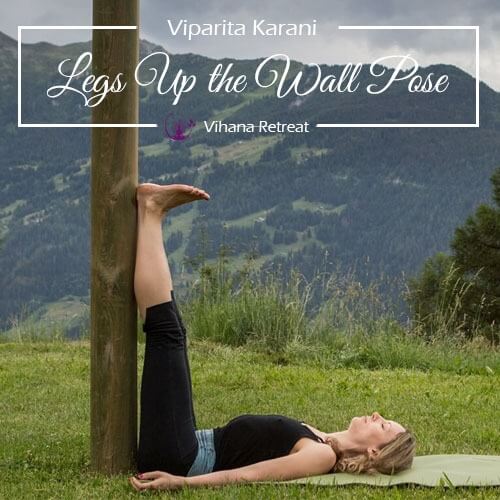
9. Corpse Pose (Savasana)
The final pose in a yoga practice is called Savasana, or Corpse Pose. This pose allows you to relax and release any tension in your body after the other poses.
Here's how to do Corpse Pose
- Lie on your back with arms at the sides, palms facing up.
- Aligning the crown of your head with the centre of the mat, extend your legs long; if there's too much tension in them, bend your knees slightly.
- Close your eyes; if you're comfortable doing so, place a hand on your heart or another point that feels soft inside (because of its openness).
- Keep breathing comfortably through your nose; notice how different qualities emerge as attention shifts from one part of the body to another; allow thoughts and emotions to float by without grasping onto them—they'll pass naturally when given time.
- If pain arises during this pose (or any other), breathe into it for a few moments before shifting position slightly or changing focus away from it until it fades away completely--we are not trying to avoid discomfort but rather learning how best to cope with what comes our way as we move through life's challenges."
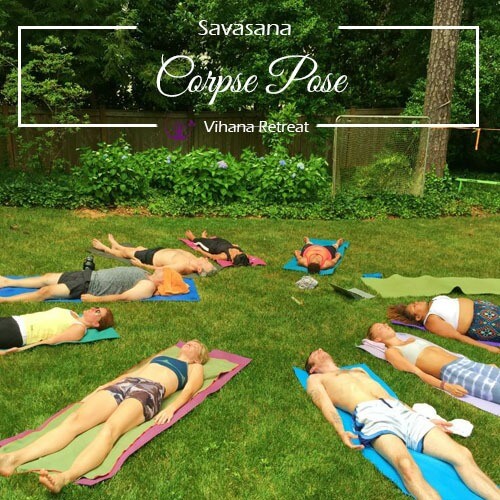
10. Extended Puppy Pose (Uttana Shishosana)
You can use this pose as part of a practice that helps manage depression and anxiety symptoms such as:
- Calming down when upset or overwhelmed
- Focusing attention inwardly rather than outwardly (which is helpful for those who tend toward distraction from outside sources)
Here's how to do Extended Puppy Pose
- Start lying on your back with your knees bent and feet flat on the floor.
- Next, extend both arms over your head with palms facing each other (like a T). Then, slowly push yourself up into an inverted V shape by lifting your hips up off the floor while keeping your legs straight.
- Hold this position for 3-5 breaths while focusing on taking deep breaths.
- Next someone who is new to yoga can modify this pose by simply lowering their feet toward their head until they feel comfortable in this position without straining their neck or back muscles too much!
- This modification allows you to still get some of those benefits without putting too much pressure on yourself at first!
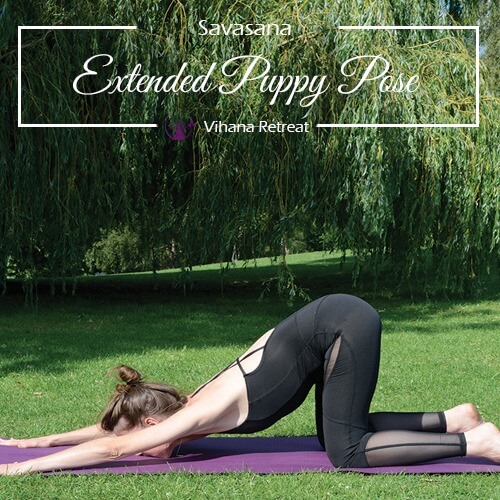
11. Reclining Bound Angle Pose (Supta Baddha Konasana)
Reclining Bound Angle Pose is a great way to get comfortable and let go of stress. You can do this pose at home, in bed, on the floor or even in a chair. It’s also known as Supta Baddha Konasana and is often referred to as Savasana with legs up the wall pose because it resembles savasana (the corpse pose).
Here's how you do Reclining Bound Angle Pose:
- Lie down on your back with both feet pointed toward the ceiling. Bend your knees and place them against each other so that they form an X shape with your thighs.
- Place your arms above your head palms down or wrap around each other for support if needed.
- Close your eyes and relax into this gentle stretch for two minutes before switching sides.
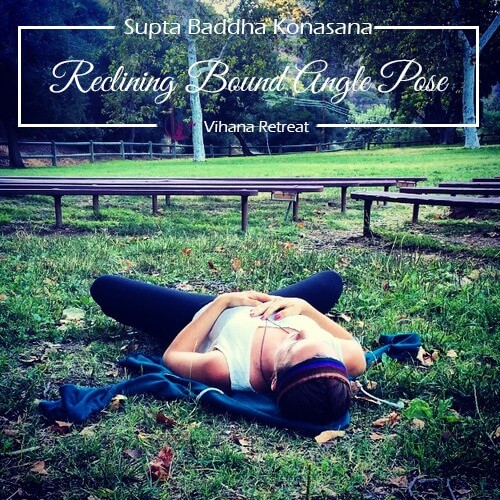
12. Camel Pose (Ustrasana)
Ustrasana is one of the most important poses in Ashtanga Yoga. It is also known as Camel Pose, and it purifies your spine as well as helping to release tension in the muscles and ligaments of your back. Ustrasana can be done on its own or during a warm-up for meditation and pranayama (breath work).
Here's how you do Camel Pose:
- Begin on your hands and knees with your wrists directly below your shoulders and knees below your hips.
- Engage your core to lift up into a push-up position, but instead of dropping down, keep pressing upward until you're resting on your forearms.
- Line up the elbows with the wrists so that if you were to look in a mirror from behind, they'd be parallel.
- Pressing through the forearms, lift up as much as possible without rounding out or bringing them too far apart from one another—this is where you might need a block or blanket for extra support under each hand if necessary.
- Inhale deeply through your nose as you press down into this pose; then exhale fully once you've reached a comfortable height (i.e., no pain).
- Hold for 5 deep breaths before releasing by lowering back down onto all fours with an inhalation at first; then exhale fully on release so that no air remains trapped inside your lungs when coming down off of this pose's full extension!
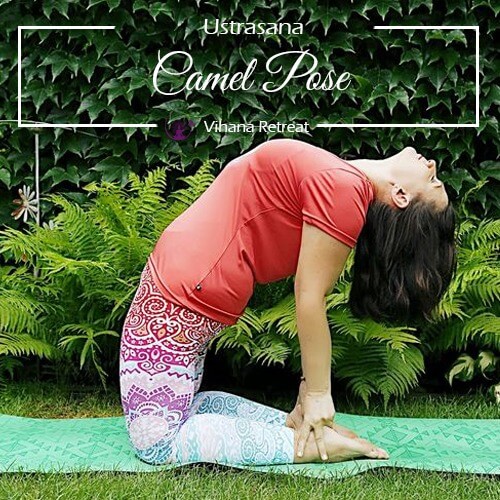
13. Downward Facing Dog Pose (Adho Mukha Svanasana)
This pose is a good one for stretching and strengthening the arms, shoulders, and legs. It also helps relieve stress, anxiety, and depression by relieving tension in the muscles of your back. This pose can also improve digestion by improving blood circulation to your gastrointestinal tract.
It improves posture by stretching your hamstrings and strengthening the core muscles of your back. Overall it improves sleep because it helps you relax physically while also calming the mind. In addition to these benefits of yoga poses for anxiety relief Downward Facing Dog Pose can also improve circulation which is key for good health overall!
Here's how you do Downward Facing Dog Pose:
- Begin on your hands and knees with your wrists directly below your shoulders and knees below your hips.
- Engage your core to lift up into a push-up position, but instead of dropping down, keep pressing upward until you're resting on your forearms.
- Line up the elbows with the wrists so that if you were to look in a mirror from behind, they'd be parallel.
- Pressing through the forearms, lift up as much as possible without rounding out or bringing them too far apart from one another—this is where you might need a block or blanket for extra support under each hand if necessary.
- Inhale deeply through your nose as you press down into this pose; then exhale fully once you've reached a comfortable height (i.e., no pain).
- Hold for 5 deep breaths before releasing by lowering back down onto all fours with an inhalation at first; then exhale fully on release so that no air remains trapped inside your lungs when coming down off of this pose's full extension!
